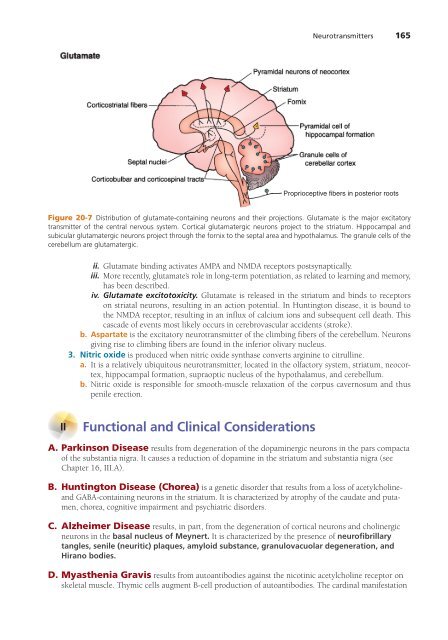You also want an ePaper? Increase the reach of your titles
YUMPU automatically turns print PDFs into web optimized ePapers that Google loves.
Neurotransmitters 165<br />
Proprioceptive fibers in posterior roots<br />
Figure 20-7 Distribution of glutamate-containing neurons and their projections. Glutamate is the major excitatory<br />
transmitter of the central nervous system. Cortical glutamatergic neurons project to the striatum. Hippocampal and<br />
subicular glutamatergic neurons project through the fornix to the septal area and hypothalamus. The granule cells of the<br />
cerebellum are glutamatergic.<br />
ii. Glutamate binding activates AMPA and NMDA receptors postsynaptically.<br />
iii. More recently, glutamate’s role in long-term potentiation, as related to learning and memory,<br />
has been described.<br />
iv. Glutamate excitotoxicity. Glutamate is released in the striatum and binds to receptors<br />
on striatal neurons, resulting in an action potential. In Huntington disease, it is bound to<br />
the NMDA receptor, resulting in an influx of calcium ions and subsequent cell death. This<br />
cascade of events most likely occurs in cerebrovascular accidents (stroke).<br />
b. Aspartate is the excitatory neurotransmitter of the climbing fibers of the cerebellum. Neurons<br />
giving rise to climbing fibers are found in the inferior olivary nucleus.<br />
3. Nitric oxide is produced when nitric oxide synthase converts arginine to citrulline.<br />
a. It is a relatively ubiquitous neurotransmitter, located in the olfactory system, striatum, neocortex,<br />
hippocampal formation, supraoptic nucleus of the hypothalamus, and cerebellum.<br />
b. Nitric oxide is responsible for smooth-muscle relaxation of the corpus cavernosum and thus<br />
penile erection.<br />
II<br />
Functional and Clinical Considerations<br />
A. Parkinson Disease results from degeneration of the dopaminergic neurons in the pars compacta<br />
of the substantia nigra. It causes a reduction of dopamine in the striatum and substantia nigra (see<br />
Chapter 16, III.A).<br />
B. Huntington Disease (Chorea) is a genetic disorder that results from a loss of acetylcholineand<br />
GABA-containing neurons in the striatum. It is characterized by atrophy of the caudate and putamen,<br />
chorea, cognitive impairment and psychiatric disorders.<br />
C. Alzheimer Disease results, in part, from the degeneration of cortical neurons and cholinergic<br />
neurons in the basal nucleus of Meynert. It is characterized by the presence of neurofibrillary<br />
tangles, senile (neuritic) plaques, amyloid substance, granulovacuolar degeneration, and<br />
Hirano bodies.<br />
D. Myasthenia Gravis results from autoantibodies against the nicotinic acetylcholine receptor on<br />
skeletal muscle. Thymic cells augment B-cell production of autoantibodies. The cardinal manifestation


